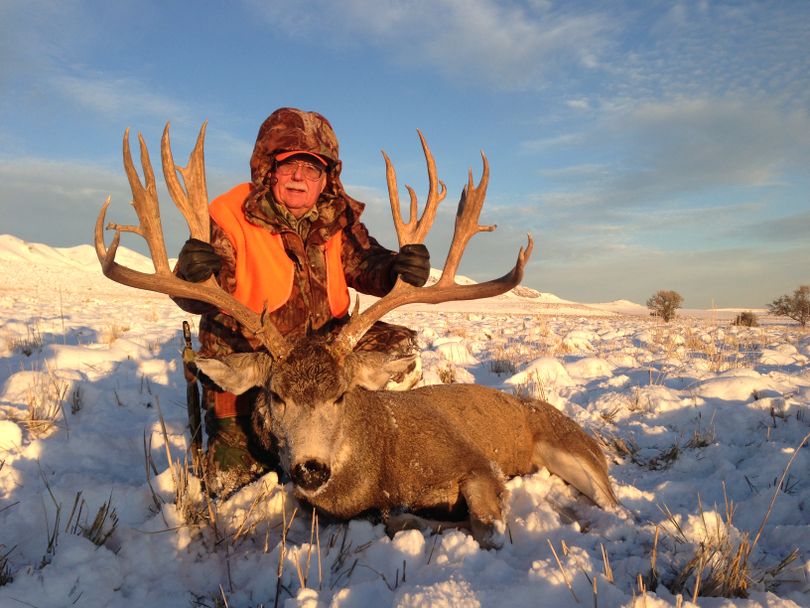Utah mule deer hunt auctioned for record $390K

HUNTING -- A bidder from Canada has set a world record high of $390,000 for the right to hunt one mule deer buck at a Utah state park in November.
"Antelope Island’s big mule deer bucks continue to produce big bucks of the green kind" for state wildlife management programs, writes Brett Prettyman of the Salt Lake Tribune.
Troy Lorenz, a 24-year-old guide from Prince George, British Columbia, made the winning bid during the annual Western Hunting and Conservation Expo held at the Salt Palace Convention Center last weekend.
“Some of the money raised from the auctions helps us run the show, but the majority of it goes to conservation projects to help all wildlife,” said Miles Moretti, president and CEO the Salt Lake-based Mule Deer Foundation. “These auctions are helping to conserve wildlife across the country.”
In all, bids for the Antelope Island mule deer hunt have generated more than $1.4 million for wildlife conservation on the preserve in the middle of the Great Salt Lake.
The Mule Deer Foundation hosts the expo in partnership with Sportsmen for Fish and Wildlife. The show draws hunting outfitters from across the world.
Here are more details about the hunting permit, the staggering bid and where the money goes from Prettyman's report:
In the auctions, well-heeled hunters spend vast sums of money for the chance to kill trophy animals. Antelope Island State Park’s mule deer herd is not included in Utah’s deer hunt, so the bucks live longer and grow much larger racks.
Last weekend’s hunting permit auctions generated $2.17 million.
Lorenz, according to Expo officials, also was the winning bidder for a statewide mule deer hunting tag in Arizona. That pricetag: $320,000.
Among the bidders for the vaunted Antelope Island mule deer tag was Denny Austad of Idaho. For three years running, Austad had made the winning bid for the permits. In all, he spent $775,000 for the chance to kill a buck each year. Austad also owns the previous world record for a mule deer hunt auction — $310,000 set in 2013 in Utah.
For years, public criticism quashed a proposed mule deer trophy hunt on Antelope Island State Park. But proponents of the hunt eventually went to Utah’s Capitol Hill and convinced lawmakers to mandate a hunt for both mule deer and bighorn sheep in the fall of 2011.
This year, the high bid for a bighorn sheep tag was $85,000. A moose permit drew a record bid of $90,000 at the Expo.
Just two tags are awarded for each species — including one permit open to the public through a lottery.
At the time they created the hunt, Utah legislators required that 90 percent of the money raised from the deer and bighorn auction permits be used for conservation efforts on the island. The other 10 percent goes to the organizers of the auction for costs associated with hosting the event.
The acutions have been so successful, just about a third of the conservation funding has been used.
Antelope Island State Park manager Jeremy Shaw said the money has been spent on a variety of projects and that none has been used as part of the park’s operating budget.
Projects range from restoring freshwater springs to installing water catchments to planting native species, including sagebrush and Mexican cliffrose.
“There is no way we could have done the number of conservation projects on the island that we have without this money,” Shaw said.
Other money has been spent transplanting 200 mule deer from the island to other Utah locations over the past two years. Biologists also attached radio collars to those deer as part of a research project to see how do after being moved.
Those transplants helped bring the island closer to a population objective of 350 to 450 mule deer. Shaw said the current population is roughly 500 animals, but the number increases during hard winters because deer from other areas migrate to the island.
The park manager cautions that the conservation money is not co-mingled with other state park funds.
“There is a perception out there that the hunting permit money is keeping Antelope Island around. All that money is used on conservation,” Shaw said. “We have our own operating budget and we make money each year. The auction money does help with the range conditions, but we don’t need it to run.”
Mule Deer Foundation and Utah Division of Wildlife Resources managers have questioned if the 26,000-acre park ever will be able to use the always-increasing pool of reserved money.
But Utah State Parks director Fred Hayes said lawmakers would have to approve a change in the funding stream to allow money generated by Antelope Island hunting permits to be used on conservation projects in other parts of the state.
